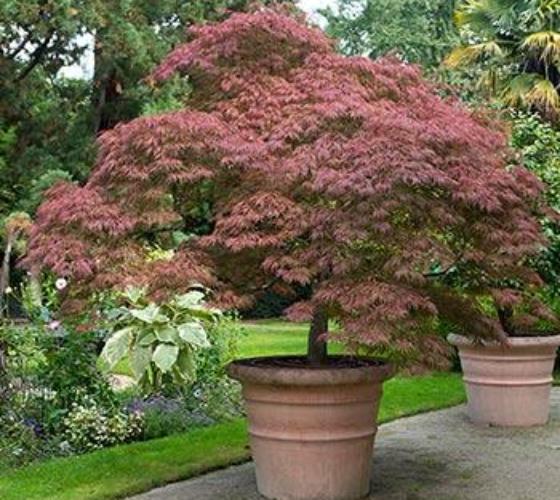

We may ask for pictures but will try to make it as easy as possible for you. If the plant is dead, has dried out roots or the incorrect item was shipped just notify Plant Addicts within 3 days upon delivery. Plant Addicts guarantees your plant(s) will arrive happy and healthy, but the plant(s) are being shipped through the mail and accidents happen. Plant Addict Guarantee (Included On All Plant Orders) Uses: Edging, Hedges & Privacy, Specimen or Focal Pointįeatures: Attracts Pollinators, Foliage Interest, Low Maintenance
Tamukeyama japanese maple in container full#
Light Exposure: Partial Shade to Full Sun (At Least 3 Hours of Direct Sunlight)

Tamukeyama Japanese Maple Information USDA Hardiness Zones: 5 - 8 When planting this Japanese Maple, you’ll want to allow space for its canopy to spread as it matures. When mature, the Tamukeyama Japanese Maple can grow to 6-8 feet tall with a spread of 8-9 feet. To encourage new growth, a slow-release fertilizer can be applied in early spring. Nevertheless, any dead or misplaced branches can be removed, and the tree can be lightly shaped when dormant in the winter. The Tamukeyama Japanese Maple rarely requires pruning. It prefers moist soil and an application of mulch annually to help conserve moisture and suppress any weeds. It can be grown in either full sun or partial shade, but appreciates some shade in the afternoon, especially in the South. However, to thrive, this Japanese Maple does require fertile, free-draining soil that is slightly acidic. Tamukeyama Japanese Maple Careĭue to its dwarf form, the Tamukeyama Japanese Maple is unlikely to interfere with any overhead structures or power lines. The Tamukeyama Japanese Maple is perfect for growing as a specimen tree where its color and texture can be appreciated. Requiring little pruning, this small tree is low maintenance and can be grown in USDA zones 5 to 8. Being deciduous, it drops its leaves as the temperatures fall to reveal a wonderful framework of deep red bark. Over time, this Japanese Maple will develop a graceful mound of weeping foliage to no more than 8 feet tall. The Tamukeyama Japanese Maple is hard to beat for color and interest. As a dwarf specimen, Tamukeyama is ideally suited for smaller or urban gardens. Botanically known as Acer palmatum dissectum 'Tamukeyama', this Japanese Maple develops a fine display of deeply dissected, crimson-red leaves in spring that turn a dark purple-red come fall. This lets smaller roots develop.With its stunning foliage and weeping form, the Tamukeyama Japanese Maple is a highly desirable specimen tree. If over time, you see that the roots of the Japanese maple in a pot touch the side or bottom of the container, it’s time for root pruning. Don’t fertilize until spring, and even then dilute a water-based fertilizer to half-strength. This helps to settle the roots in the soil. Use good quality potting soil to fill the pot. It is imperative that the pot has one or more drainage holes. If you want a healthy, happy, container-grown Japanese maple, you’ll need to plant your tree in a container that is about twice the size of the tree’s root system. If you pick a tree that doesn’t get taller than 10 feet (3 m.) tall, you won’t have to do annual pruning. Generally, these maples grow slower in pots and develop smaller root systems. Pick dwarf or semi-dwarf species for your potted Japanese maples. With hundreds of different Japanese maple cultivars available in commerce, you need to choose one that will grow in your plant hardiness zone. The first step toward having a container-grown Japanese maple is to determine a variety that would work well in your area. To start one or more potted Japanese maples, you need a large container, good potting soil, and a partially sunny location for it.

It’s not that hard to start growing Japanese maples in containers. So do small deciduous trees like the Japanese maple. Smaller species and dwarf varieties of evergreens usually do well as container-grown plants.

You can grow both evergreen and deciduous trees in containers. The smaller the mature size of the species, the more likely it is that the tree will grow happily in a large pot. Many different types of trees thrive in containers. Growing Japanese maples in containers is not as unusual as you may think. Can Japanese Maples Be Grown in Containers? If you are interested in planting a Japanese maple in a pot, here’s all the information you’ll need to get started.
Tamukeyama japanese maple in container how to#
These graceful, slender maple trees ( Acer palmatum) thrive in pots as long as you know how to plant them. If you have a porch, a patio, or even a fire escape, you have what you need to start growing Japanese maples in containers. Can Japanese maples be grown in containers? Yes, they can.


 0 kommentar(er)
0 kommentar(er)
